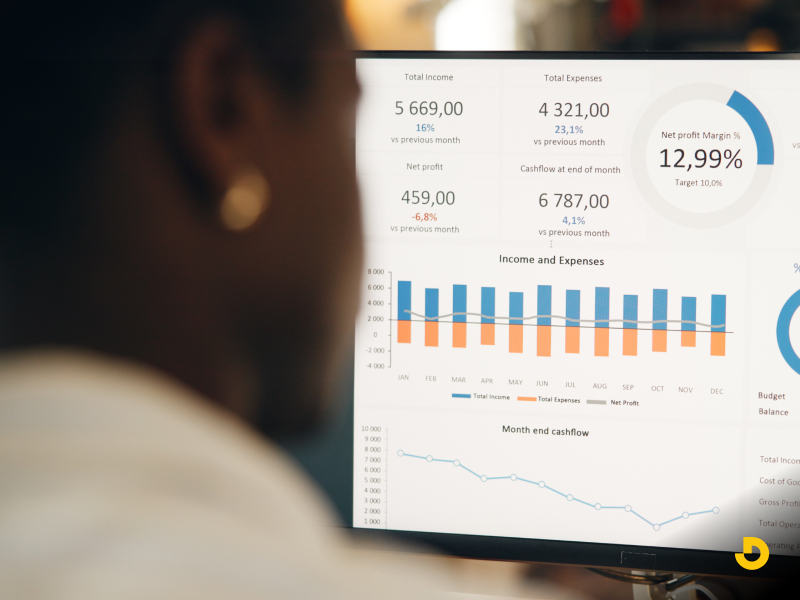Introduction
Web design isn't just about making things look pretty anymore (though, let's be honest, aesthetics still matter). In today's digital world, it's less about "I think this button should be blue" and more about "The data says 63% of users clicked the green one." Surprise---your gut feeling isn't always right.
Businesses aren't just picking colors from a mood board these days. They're digging into user behavior, tracking performance like obsessed sports fans, and using real-time insights to tweak---ahem, tweak---every little thing. Because a website that looks good but doesn't work? That's like a sports car with no engine. Cool to stare at, useless when you need it.
Remember the old "launch and pray" method? Yeah, that doesn't cut it anymore. Users are impatient, competition is fierce, and Google's always changing the rules. You can't just cross your fingers and hope people figure out your confusing menu. You need cold, hard data to tell you: "Hey, 80% of visitors bail before even scrolling. Maybe fix that?"
For businesses in Delaware (or anywhere, really), analytics aren't some fancy add-on---they're the backbone of smart web design. Whether you're a scrappy startup or a big-name brand, data is what turns a "meh" site into a lead-generating, conversion-crushing machine. Because at the end of the day, a website's job isn't to win design awards---it's to win customers.
The Rise of Data in Modern Web Design
The digital landscape has flipped the script---your website isn't something you "set and forget" anymore. It's more like a high-performance engine that needs constant tuning based on real-world feedback.
We've moved past the era where designers could rely on hunches or industry trends. Now, with tools tracking everything from cursor movements to rage clicks, your website literally tells you what's working (and what's driving users away). Consider this wake-up call: Nearly 9 out of 10 visitors will abandon your site after just one poor experience. That loading spinner that takes just a second too long? That mobile menu that requires a PhD to navigate? They're not just minor annoyances---they're conversion killers.
Today's users have zero patience. They expect:
- ✓ Pages that load faster than they can blink
- ✓ Experiences tailored to their device and habits
- ✓ Navigation so intuitive it feels psychic
This is why forward-thinking agencies---whether in Delaware or Dubai---are putting data at the core of every design decision. Because in today's cutthroat digital world, guessing is a luxury no business can afford.

Where the Data Comes From: Analytics Tools That Drive Smarter Design
If you want a website that truly delivers results, you need more than just creativity---you need the right data. And luckily, there are powerful tools that reveal exactly how users interact with your site.
Google Analytics
- Tracks visitor sources, behavior flows, and exit points
- Identifies top-performing content and audience demographics
Hotjar/Microsoft Clarity
- Visualizes user behavior through heatmaps and session recordings
- Exacts frustrating UX elements and engagement patterns
PageSpeed Insights
- Diagnoses loading speed and performance bottlenecks
- Measures Core Web Vitals for optimal user experience
Ahrefs/SEMrush
- Analyzes SEO performance and keyword opportunities
- Reveals competitor strategies and content gaps
Key Metrics That Shape Design and Development
"Numbers don't lie - and when it comes to building websites that actually perform, they tell the whole story. We're way past the days when design was just about what looks pretty. Today, the real magic happens when you let user behavior data guide every decision, from where to place that 'Buy Now' button to how your mobile menu should work. The right metrics show you exactly what's working (and what's driving visitors away) so you can make changes that move the needle for your business."
Bounce Rate
- Your "uh-oh" metric - shows who's leaving immediately
- High number? Your page isn't delivering what visitors expect
Scroll Depth
- The truth-teller about your content
- Find out where readers zone out (usually way sooner than you'd hope)
Load Time
- Every second = 7% fewer conversions
- Not just user experience - this is revenue protection
Device Usage
- Reveals whether you're designing for phones or desktops
- Spoiler: It's probably mobile (and your site better be too)
Conversion Funnel Leaks
- Shows exactly where potential customers bail
- The difference between "almost bought" and "actually bought"

Why Data-Backed Design Wins in 2025 (The Numbers Don't Lie)
Recent analytics reviews reveal a harsh truth---many "perfect" homepage designs fail to engage visitors, with over 70% never scrolling past the first screen. It's a wake-up call for any business still relying on intuition rather than data.
The evidence is overwhelming. Studies confirm that companies using data-driven design strategies consistently outperform competitors, seeing up to six times greater profit growth. That's not just an improvement---it's a complete transformation in results.
Consider this: research shows users now judge websites within 50 milliseconds---faster than conscious thought. First impressions are instant, and there's no room for error.
- Key insights from real-world heatmaps and session recordings:
- Hero images often get ignored entirely
- "Intuitive" navigation frequently confuses users
- Loading animations regularly hurt conversion rates
This isn't just design anymore---it's behavioral science. The most successful websites treat every decision as an experiment, testing and refining based on real user actions.
In 2025, guessing is no longer an option. Data-driven design has become the baseline for survival in a competitive digital landscape. Businesses that ignore analytics aren't just falling behind---they're becoming irrelevant.
Delaware Businesses Are Going All-In on Data-Driven Design
Something interesting is happening across Delaware's business landscape. From boutique shops in Wilmington to beachside restaurants in Bethany, local businesses aren't just dipping their toes into digital---they're diving in headfirst.
The numbers tell the story:
- Over 60% of Delaware SMBs now use web analytics tools (up from just 32% in 2020)
- Businesses tracking performance metrics report 2-3x faster conversion growth
- Mobile-optimized local sites see 40% longer visitor engagement
What's driving this? Simple---results. When the local hardware store starts outranking big box retailers in search results, or the family dental practice books more appointments online than ever before, the value becomes undeniable. Delaware's business owners are proving you don't need a Silicon Valley budget to compete digitally. You just need the right data---and the willingness to act on it. In 2025, that combination is turning local shops into local success stories.
Take a walk down Main Street in any Delaware town, and you'll see the shift:
- The bakery using heatmaps to rearrange its online menu
- The accounting firm that doubled leads after fixing bounce rate issues
- The marina that boosted bookings by 75% through scroll depth optimization
Practical Ways Analytics Influence Web Design Decisions
Let's be honest - most of us design based on what looks good to us. But the truth is, your analytics are screaming clues about what actually works. I've seen it time and again working with businesses from Wilmington to Dover - the numbers don't lie.
Here's the real deal on using data to build better sites:
Navigation That Doesn't Suck:
Remember that time you couldn't find the menu at that restaurant? Your users feel that way right now. Tools like Hotjar show where people bail in frustration. If your "Services" page has visitors leaving faster than a bad date, that's your wake-up call. What works: Ditch the clever menu names. Go obvious. If grandma can't find it in 3 clicks, simplify.
Strategic Placement of CTAs (Calls-to-Action):
Data shows where users click, scroll, and stop paying attention. With this insight, you can place CTAs exactly where they're most likely to drive action---be it signing up, scheduling a demo, or completing a checkout. Instead of guessing, you're placing high-value actions in high-engagement zones, which leads to better performance without bloated interfaces.
Buttons People Actually Press:
That beautiful CTA that matches your color scheme? Yeah, no one's clicking it. Heatmaps show the "sweet spots" where eyes naturally land. Put your important stuff there, not where it "looks balanced." Pro tip: If your main button is competing with too much visual noise, you've already lost.
Writing Humans Read (Not Robots):
Here's a hard truth - your carefully crafted 1,500 word homepage? Most visitors read about 20% of it. Scroll maps don't care about your feelings. If your key offer is buried, move it up before the "TL;DR" kicks in.
Speed or Die:
I once watched a site lose 12% of its sales just from 1 extra second of load time. Tools like PageSpeed Insights will show you the usual suspects - oversized images, bloated code, third-party scripts. Fix these first.
Balancing Creative Freedom with Data-Backed Strategy
Some designers fear analytics will kill creativity. Truth? Data just makes it smarter.
Your bold coffee shop design might look amazing---but if heatmaps show users bouncing before scrolling, it's not working. That's not failure---it's feedback.
Here's the magic formula:
- Start with creative vision (that gorgeous hero image)
- Refine with real user data (move the CTA higher if no one sees it)
- Keep what works, tweak what doesn't
"Design without data is art. Design with data gets results."
The best designs? They're equal parts beautiful and functional---with analytics as your secret weapon. Ever had to change a design you loved because the data said so? (We've all been there.)
How Delaware Businesses Can Benefit from Data-Driven Web Design
Look, every business in Delaware wants more customers online. But guess what? Your website might be working against you. Here's the real deal:
Data isn't just numbers - it's your secret weapon. When we see Wilmington customers bouncing off your pricing page or Dover visitors ignoring your main offer, that's gold. We can fix what's broken and double down on what works.
- Local businesses win when they:
- Stop guessing what customers want
- Fix the pages where people keep leaving
- Show the right message to each town's visitors
- Make their site load fast (especially on phones)
The coffee shop down the street? They moved their "Order Online" button based on customer clicks and saw 30% more orders. That's the power of paying attention.
Bottom line: Your website should work as hard as you do. When it's tuned to real customer behavior, you get more leads, more sales, and happier clients. No magic - just listening to what the data tells us.
Future Trends: What's Next in Data-Driven Design
You know how everyone's always shouting about "the next big thing" in web design? Let me tell you what's actually moving the needle right now - stuff I've seen work for real businesses.
Websites That Get You (Like a Good Bartender):
Remember when websites were basically digital brochures? Now the good ones actually respond to what you're looking for. I saw this cool example at a Rehoboth Beach hotel - their site started showing pet policy details to visitors who had been checking out local dog parks. Not because it's psychic, but because it's finally smart enough to connect those dots
One-Size-Fits-All is Dead (Thank God):
We've all suffered through generic websites that treat every visitor the same. Now? Your Newark accounting firm's site can automatically show different stuff to small business owners versus individuals filing personal taxes. And the best part? It happens without you having to manually create twenty different versions
"Just Say It" Navigation:
Voice search isn't coming - it's here. I recently watched a customer try to verbally ask a restaurant's website about gluten-free options. When it failed? They bounced to a competitor. That won't fly much longer.
Tracking That Doesn't Feel Sketchy:
With all the new privacy laws, we've had to get creative. The new analytics tools still show what's working, just without creepy surveillance. Honestly? They often give better insights anyway.
AI That Actually Helps:
Not the overhyped AI - the practical kind. Tools that automatically flag when 40% of mobile users miss your contact button. Or that spot checkout forms causing rage clicks. It's like having an extra set of expert eyes.
Conclusion
Look, here's the truth about websites today - if yours isn't actively working to grow your business, it's basically just an expensive online brochure. we've worked with enough Delaware businesses to know that what separates the winners from the rest isn't flashy design (though that helps), but whether the site actually connects with real customers.
You know what's crazy? Some of the biggest improvements come from the simplest changes. That bakery in Wilmington that doubled their online orders? Just moved their "Order Now" button. The Dover contractor getting 3x more leads? Fixed one confusing form field. These aren't miracles - they're the result of paying attention to what real users actually do on the site.
- Here's what I tell every business owner:
- Your website should be your best salesperson, not your prettiest business card
- Little tweaks often make a bigger difference than complete redesigns
- If you're not looking at how real customers use your site, you're just guessing
The good news? You don't need to be a tech whiz to start improving things. Check your Google Analytics. Watch some session recordings. Ask a few customers to try completing an action on your site. You'll probably spot obvious fixes within an hour.
Want to see real examples of Delaware businesses that transformed their results with these approaches? At Designocracy, we're happy to share case studies - no sales pitch, just honest insights from what's actually working right now in our local market. Sometimes all it takes is seeing what's possible to realize how much better your site could be performing.






